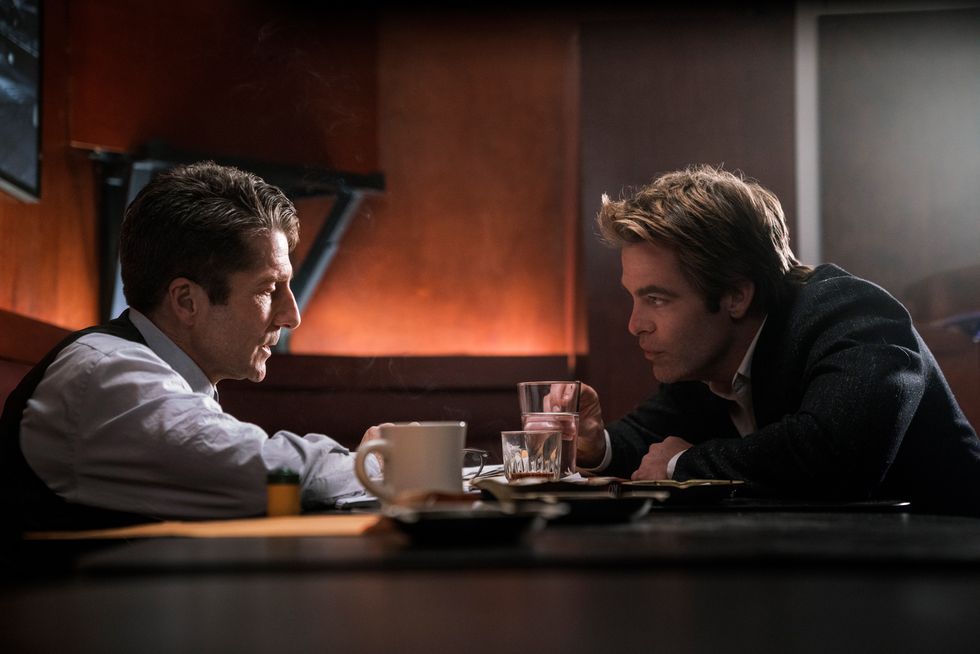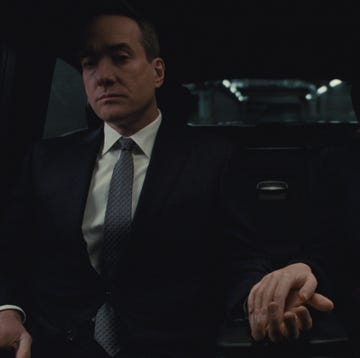Whenever I think back to the J.J. Abrams Star Trek movies, the only section I can vividly remember is the first act of the 2009 James Tiberius Kirk origin story. Chris Pine’s version of the space captain is equal parts sleazy and cocky. But he’s a good natured punk, one who knows how to use his street smarts to get out of the tough circumstances he’s been born into. His inherent charm is offset only by his brash approach to doing the right thing. That’s also what made him so phenomenal in Hell or High Water, as a Red State loser who will do anything to better his own position. Somehow, he’s so convincing as poverty stricken small-time crook that you forget he’s so goddamn handsome. That’s a rare skill—a Matthew Mcconaughey-type transformation that none of the other famous Chrises could pull off.
So it’s extremely Chris Pine that we first see him in I Am the Night awkwardly running across a beach wearing socks. Early in the pilot, he describes himself as the common thread among all great Chris Pine characters: “I’m a stringer for The Examiner. I’m a loser. Can you dig it?”
Yes, Chris, I can absolutely dig it. From his first lines, he has that panicked and stuttering everyman kind of charisma. He’s the anti Hollywood star—so very much the opposite of his pretty boy Marvel namesakes. He’s the one who shines in a supporting role opposite Gal Gadot's Wonder Woman, and now he re-teams with his Wonder Woman director Patty Jenkins for the vintage noir crime TV series she's produced.
After his own penis overshadowed his performance in Netflix’s Outlaw King, Pine takes another unexpected pivot as a leading man in the TNT series. Pine plays Jay Singletary, a disgraced journalist who began working for the tabloids after his career reporting for the Los Angeles Times was destroyed by Los Angeles doctor George Hodel. Singletary wrote an article about Hodel in 1949, two years after the dismembered body of Elizabeth Short—known infamously as the Black Dahlia—was discovered in a vacant lot in Los Angeles. (The real-life Hodel remains the case's prime suspect seven decades after Short's murder thanks to a book written by son, a former LAPD detective, that makes a case for Hodel's guilt.) Taking place almost two decades later in 1965, I Am the Night also follows Hodel's estranged granddaughter, Fauna Hodel (India Eisley), as she lands in L.A. in order to reconnect with her family. (The show is loosely based on Fauna’s own 2008 memoir, One Day She’ll Darken.)
The Hodel family, as you might imagine, has some issues. And Singletary and Fauna Hodel eventually cross paths as the former investigates a new serial killer the papers are calling "Bloody Romeo." That mystery itself isn’t quite as fun as it is stylish, but Pine gives brings momentum to the plot, playing his broken and drug-addled Korean War vet with charisma and wit as he navigates the sleazy underbelly of 1960s Hollywood. And for what’s otherwise an uneven series, Pine absolutely makes it worth watching. It’s fun as hell to watch him bumbling through his investigation, watching him get his ass kicked repeatedly. (In fact, like in Star Trek, Pine shows in this series that he’s phenomenal at acting like someone who just got beaten up. For most of the second episode, he has a bloody eye in a nice nod to Chinatown.)
If you’re mildly interested in the Black Dahlia case and the larger implications of Short's unsolved murder, go ahead and give I Am the Night a watch. But I’m really here for Pine, his bloody face, and his vintage suits. For any Chris Pine connoisseur, he proves that he's more than ready to be the leading man we want him to be.
Matt Miller is a Brooklyn-based culture/lifestyle writer and music critic whose work has appeared in Esquire, Forbes, The Denver Post, and documentaries.















